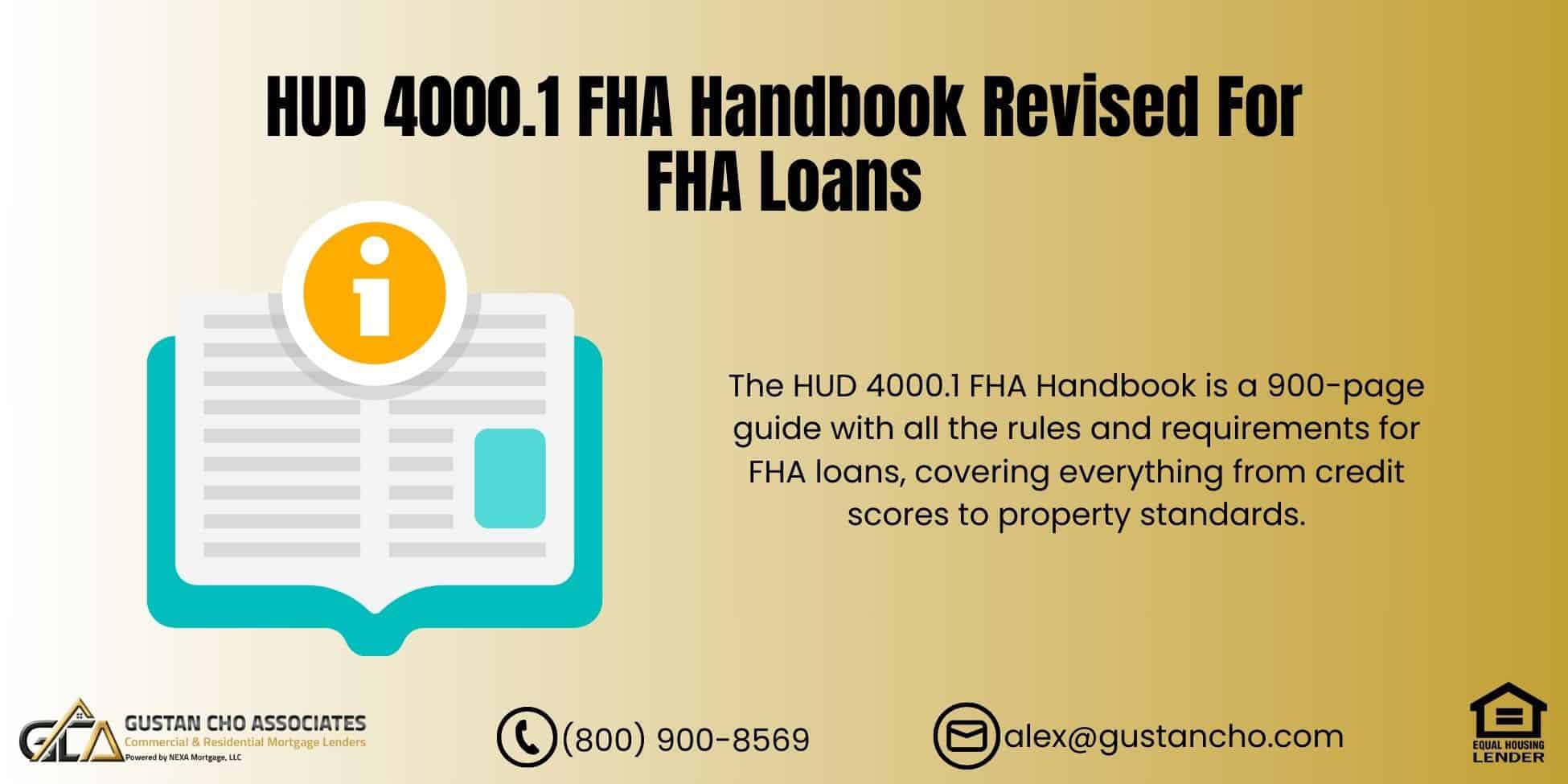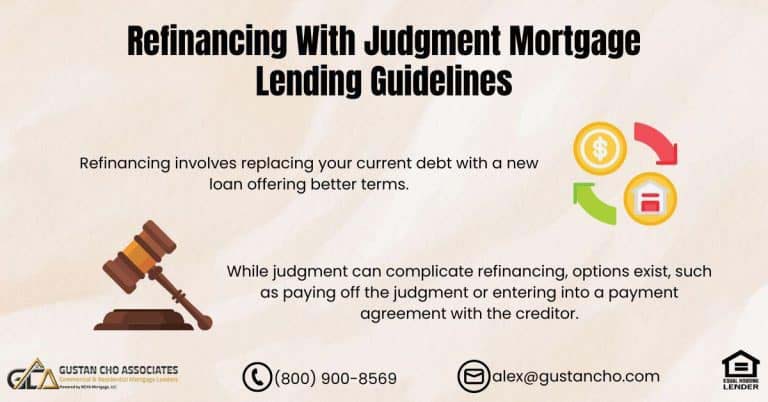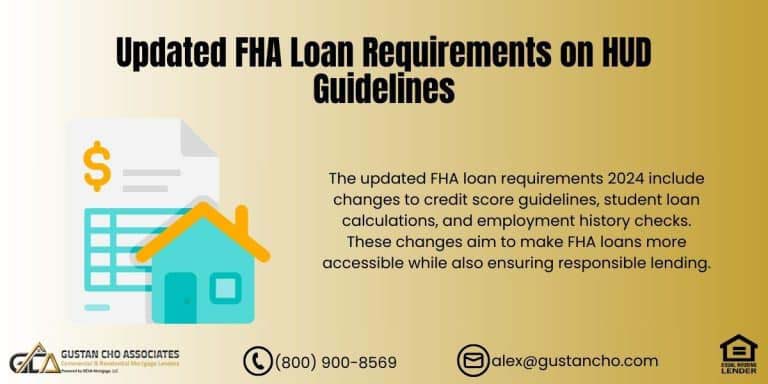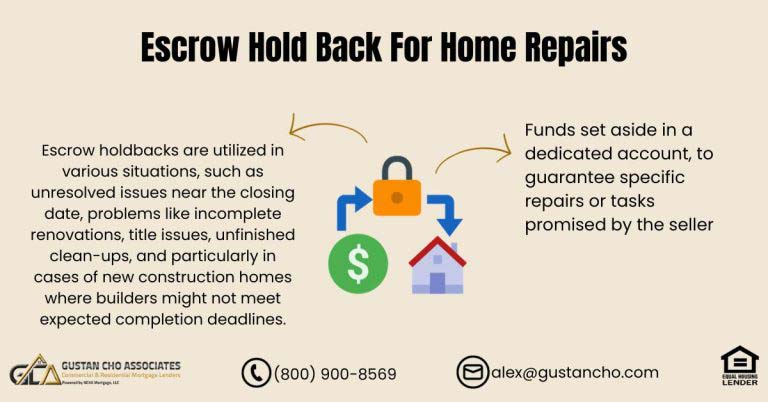This blog is a short-cut guide to the HUD 4000.1 FHA Handbook Revised For FHA Loans. The HUD 4000.1 FHA handbook revised for FHA loans is a 900 comprehensive list of mortgage guidelines and requirements for FHA loans. We created a cliff notes version for borrowers on purchase and refinance transactions that most borrowers had frequently asked questions on FHA guidelines. HUD provides guidelines and requirements for FHA (Federal Housing Administration) loans through its FHA Handbook 4000.1. These guidelines cover various aspects of FHA loans, including borrower eligibility, property requirements, loan limits, credit and income criteria, and more. In the following paragraphs, we will cover the key aspects of HUD guidelines on FHA loans. In the following paragraphs, we will cover the HUD 4000.1 FHA Handbook revised for FHA loans.
HUD 4000.1 FHA Handbook Revised For FHA Loans Borrower Eligibility
Borrowers must have a valid Social Security Number (SSN) or Individual Taxpayer Identification Number (ITIN). Borrowers must be U.S. citizens, permanent residents, or eligible non-citizens. Credit scores can vary but generally should meet minimum standards set by the FHA and the lender. Past bankruptcies, foreclosures, and other significant credit events may affect eligibility.
FHA loans require a minimum down payment of 3.5% of the purchase price. Down payment funds can come from personal savings, gifts, grants, or approved down payment assistance programs. Borrowers’ debt-to-income (DTI) ratios should generally be within acceptable limits, typically at most 43% of gross income.
Property Requirements
FHA-approved properties must meet specific standards, including safety and liveability criteria. An FHA appraisal is required to determine the property’s condition and value.
Mortgage Insurance
FHA loans require an upfront mortgage insurance premium (MIP) and an annual MIP, which can be included in the loan amount. Borrowers pay MIP to protect lenders against potential losses.
FHA Loan Limits
FHA loan limits vary by location and are subject to change annually. Borrowers can check the current limits for their area on the HUD website.
Loan Types
HUD offers various loan programs, including purchase loans, streamlined refinances, and rehabilitation loans (FHA 203(k)). Borrowers are generally required to use FHA loans for their primary residence. Borrowers must provide the necessary documentation, including income, employment, and asset verification, as lenders and HUD guidelines require.
Non-Occupying Co-Borrowers
HUD allows the use of non-occupying co-borrowers to help qualify for a loan. It’s essential to consult with an FHA-approved lender or a mortgage professional for the most up-to-date information on FHA loan requirements and to determine your eligibility based on your specific financial situation and the property you intend to purchase. FHA guidelines may change over time, so it’s crucial to stay informed of the latest updates from HUD.
What Is the HUD 4000.1 FHA Handbook Revised For FHA Loans
What Is The HUD 4000.1 FHA Handbook? The actual HUD 4000.1 FHA Handbook is almost 900 pages. We published this blog to summarize the most important guidelines our viewers have the most questions about. FHA mortgage lending guidelines are set and implemented by the United States Department of Housing and Urban Development or HUD. HUD is the parent of the Federal Housing Administration, commonly known by many as FHA. Borrowers who need FHA loan approvals need to meet the minimum FHA Guidelines which are set by the HUD 4000.1 FHA Handbook. The HUD 4000.1 FHA Handbook consists of over 900 pages of FHA mortgage lending guidelines which consist of the following:
- minimum credit score requirements
- FHA debt to income ratio requirements
- FHA Guidelines On Collections Accounts And Charge Offs
- FHA Guidelines On Co-Borrowers
Every other possible case scenario on FHA Loans is listed on the HUD 4000.1 FHA Handbook: HUD FHA Handbook changes periodically with new FHA Guidelines. How often? Nobody knows.
HUD Guidelines Versus Mortgage Overlays
Not every FHA lenders have the same FHA loan requirements for their borrowers. As an example, FHA Guidelines on minimum credit score requirements for a 3.5% down payment home purchase is 580. However, most lenders do not care about the 580 credit score requirements. Many will require credit scores of 620.
The higher lending requirements by the individual lender is called overlays on credit scores. All lenders need to follow the minimum lending guidelines on HUD 4000.1. FHA Handbook.
Most lenders have higher mortgage requirements on FHA loans that are above and beyond the minimum HUD 4000.1 FHA Handbook. These higher lending requirements are called mortgage lender overlays. Gustan Cho Associates is one of the few mortgage companies licensed in multiple state with no mortgage overlays on FHA loans. Gustan Cho Associates just go off HUD Guidelines.
Typical Lender Overlays on FHA Loans
Here are typical FHA lender overlays: Credit Scores:
- HUD Guidelines on minimum credit scores is 580 but most require a 620
- HUD allow borrowers with under 580 credit scores and down to 500 FICO to qualify for FHA loans with a 10% down payment
- However, many FHA lenders will not allow borrowers with under 580 credit scores to qualify for FHA loans as part of their lender overlays
Agency Guidelines Versus Lender Overlays on Debt-to-Income Ratio
HUD allows up to 46.9% front end and 56.9% back end DTI on borrowers with 620 scores and higher. Under 620 require debt to income ratio determined by the automated underwriting system (AUS) findings
Outstanding Collection and Charge-Off Accounts
Borrowers do not have to pay outstanding charged-off accounts and collections. Many lenders have overlays where they require borrowers to pay outstanding collections and charged off account.
Mortgage During and After Chapter 13 Bankruptcy
Borrowers can qualify for FHA Home Loans During and After Chapter 13 Bankruptcy. Most Lenders require a two year waiting period after the Chapter 13 Bankruptcy discharged date. Whatever FHA Guidelines are on HUD 4000.1 FHA Handbook, that is what we just go off.
HUD 4000.1 FHA Handbook on Changes in Student Loans
The revised HUD 4000.1 FHA Handbook implemented major changes in FHA Guidelines on deferred student loans. The old HUD FHA Handbook allowed deferred student loan payments from the date of closing to be excluded from the borrower’s debt-to-income ratio calculations. Student loans that have been deferred for 12 or more months were excluded from debt-to-income calculations under the old HUD Handbook. U
nder the new HUD 4000.1 FHA Handbook on deferred student loans, mortgage underwriters need to include monthly student loan payments. Even if the student loan payments have been deferred for more than 12 months. 1.0% of the student loan balance is counted as a monthly debt on deferred student loans. Income-Based Repayment (IBR) no longer counts with FHA loans. Income-Based Repayment (IBR) is allowed with conventional loans as long as the IBR Payment reports to all three credit bureaus.
Creative Solutions For Borrowers With Large Student Loan Balances
In lieu of 0.50% of the student loan balance, some lenders, like Gustan Cho Associates will take a fully amortized monthly payment over an extended-term (25 years) from the student loan provider if the number is lower than 0.50% of the outstanding student loan balance. Contact the student loan provider and tell them that you are applying for a mortgage and your lender needs a fully amortized monthly payment over an extended term.
Get the verbal monthly amount and ask them to send it in writing. This figure normally turns out to be under 0.50% of the outstanding student loan balance. HUD now accepts income-based repayments that report on consumer credit reports including zero monthly IBR payments. The Team at Gustan Cho Associates have helped countless borrowers get FHA loans using this strategy versus taking the 0.50% of the student loan balance.
Exempt Debts From DTI Calculations

HUD 4000.1 FHA Handbook Changes in FHA Streamline Refinances
Under the old HUD FHA Handbook, the rule to be able to do an FHA Streamline Refinance Mortgage, the homeowner was required to save at least 5% of the principal, interest, and FHA mortgage insurance premium payment. Under the Revised New HUD 4000.1 FHA Handbook, homeowners need to have savings of at least half of one percent, 0.50%, off their current mortgage interest rate and FHA mortgage insurance premium.
FHA Loans After Timeshare Foreclosure
Under HUD Guidelines, Timeshares are not real estate. Timeshares are classified as installment loans. Under FHA Mortgage Guidelines there is no waiting period after Timeshare Foreclosure to qualify for FHA loans. Many Lenders treat timeshare foreclosures the same as real estate property foreclosure and deny mortgage borrowers. The Team at Gustan Cho Associates has helped countless mortgage borrowers with timeshare foreclosures with no waiting period.
HUD Guidelines During and After Chapter 13 Bankruptcy
Home Buyers can qualify for FHA loans 2 years after Chapter 7 and Chapter 13 Bankruptcy discharged date. Most lenders do not accept any borrowers during and after Chapter 13 Bankruptcy. However, under HUD Guidelines, borrowers can qualify for FHA home loans during Chapter 13 Bankruptcy Repayment Plan. 12 months needs to have passed with timely payments. to qualify for an FHA loan during Chapter 13 Bankruptcy repayment. Trustee Approval is required.
I have never seen a case where the Chapter 13 Bankruptcy Trustee does not approve a borrower during Chapter 13 repayment period. There is no waiting period after Chapter 13 Bankruptcy discharge date. Any Chapter 13 Bankruptcy FHA loans with under 2-year seasoning of the discharged date needs to be manual underwriting. This guideline also applies to VA loans. Veteran Borrowers can qualify for VA home loans during and after Chapter 13 Bankruptcy.
FHA Guidelines on Collection and Charged-Off Accounts
Mortgage borrowers do not have to pay outstanding collection accounts or charged-off accounts to qualify for FHA home loans no matter what the outstanding balance is. However, if the aggregate total of non-medical collections surpasses $2,000, then 5% of the outstanding balance is used as a monthly debt and used to calculate borrowers’ debt-to-income ratios. If the borrower has $10,000 in outstanding collections, then 5% of the $10,000 or $500 is used as a hypothetical debt and will be used to calculate DTI even though the borrower does not have to pay a dime. If the 5% figure is too much and exceeds the debt to income ratio caps, then the borrower can enter into a written payment agreement with the creditor. That payment agreed upon can be used as the monthly debt in lieu of the $500.
Can I Qualify For FHA Loans With Outstanding Judgments and Tax Liens
Home Buyers can qualify for FHA home loans with outstanding judgments and tax liens without having to pay them off. Need a written payment agreement with the judgment creditor or Internal Revenue Service. Three months of timely payments need to have been made. Proof of payment needs to be provided to the lender with three months of canceled checks or bank statements. Cannot prepay three months upfront to qualify for a mortgage. Three months of payment seasoning is mandatory.
HUD Guidelines on Credit Disputes on FHA Loans
Credit Disputes During Mortgage Process is prohibited by HUD. All credit disputes need to be retracted. Any mortgage loan application with credit disputes will be suspended until credit disputes are removed. However, there are exemptions: Credit Disputes on medical collections are exempt from retraction. Any credit disputes on non-medical collections with zero balances are exempt from retraction. If the total balance of all non-medical credit disputes equals less than $1,000, it is exempt from retracting it.
HUD 4000.1 FHA Handbook Changes For Borrowers With More Than One FHA Loan
HUD allows borrowers to have more than one FHA loan if they get a job transfer where the commuting distance is too far from their home. Under the old FHA Handbook, a home buyer can have two FHA loans under the following circumstances: If they were to relocate due to their jobs and the commuting distance was beyond a reasonable distance. Under the Revised HUD 4000.1 FHA Handbook, a borrower can have two FHA loans if and only if the relocation of employment is more than 100 miles commuting distance from their original main residence to their job relocation. Here is a useful like about the hud homes network by HUD.
HUD 4000.1 FHA Handbook on Social Security and Pension Income
Social security income and pension income counts as qualified income for FHA loans. Under the old FHA Handbook, non-taxable income such as social security income and pension income could have been grossed up by 0.25% if the borrower did not file a tax return. Under the new revised HUD 4000.1 FHA Handbook, the borrower can gross up their social security or pension income using the greater of 15% or the FHA borrower’s actual income tax rate. In the event, if the borrower did not file an income tax return, then mortgage underwriters will utilize the income tax rate of 15%.
HUD 4000.1 FHA Handbook on Manual Underwriting
Under the old FHA Handbook, all manual underwriting was up to the underwriter’s discretion as long as the borrower had compensating factors. Under the revised new HUD 4000.1 FHA Handbook, all manual underwriting FHA loans require verification of rent. Verification of rent is only valid if borrowers provide 12 months of canceled checks or 12 months of online bank statements. This is required to show that they have made timely monthly rental payments to their landlord. If the borrower had a mortgage, then no more than two 30 day late payments are allowed in the past 24 months.
Mortgage Underwriter Discretion on Manual Underwriting
Mortgage underwriters who are doing a manual underwrite may approve borrowers who have an acceptable payment history as long as the borrower has not had any major late payment or derogatory credit payment history on their credit accounts. This holds true especially for revolving credit accounts for the past 12 months. Major derogatory credit is defined as any revolving credit accounts that are credit payments that are more than 90 days or more past due after the initial payment due there and/or three or more credit accounts that are 60 days or later from the initial due date.
Qualifying For FHA Loans With a Lender With No Overlays
Apply Online And Get recommendations From Loan Experts
Qualifying For FHA Loans With a Lender With No Overlays
Gustan Cho Associates is a national mortgage company with no lender overlays on government and conventional loans. Over 75% of our borrowers are folks who could not qualify at other banks and lenders due to their lender overlays.
Gustan Cho Associates has ZERO OVERLAYS on FHA loans and we just go off Automated Underwriting System Findings and just follow HUD 4000.1 FHA Handbook Guidelines.
Homebuyers and homeowners who need to qualify with a FHA lender with no mortgage overlays, please contact us at Gustan Cho Associates at 800-900-8569 or text us for a faster response. Or email us at gcho@gustancho.com. We are available 7 days a week, evenings, weekends, and holidays.
Updated HUD 4000.1 FHA Handbook Revised for FHA Loans
The Federal Housing Administration (FHA) has published an updated version of its Single Family Housing Policy Handbook 4000.1, which aims to offer more straightforward policies for FHA-approved lenders and other stakeholders.
We Will Go Through Some Crucial Updates Today.
- FHA Assumption Fees: Under modern market conditions, the processing fee charged for borrowers adjusting a pre-existing FHA-insured mortgage has risen from $900 to $1000.
- Servicing Transfers: Servicers are now mandated to change borrowers’ language preferences from English to Spanish during servicing rights transfers to facilitate communication with borrowers who do not speak the language.
- Servicing Review Defect Taxonomy: The FHA developed a further Defect Taxonomy encompassing Title II servicing loan reviews, which was implemented on January 15, 2025. These changes have improved the stability of determining defects on a loan basis.
- FHA Appraisal Reporting: These changes have met the requirements for using the Market Conditions Addendum (Form 1004MC) on appraisal reports.
- Water Supply Systems: For better water safety standards, properties that use certain water sources, including mechanical chlorinators or construction next to springs, lakes, rivers, sand-point wells, or artesian wells, can now not utilize FHA mortgage insurance.
Estimate Payment History For Refinance
The need to present a certain mortgage repayment history when the existing mortgage is not in the borrower’s name has been further clarified for automated and manual underwriting.
- These updates will apply for all mortgages with case numbers given, appraisal start dates, and condominium project approval submissions done on and after April 10, 2025.
- Lenders and stakeholders are encouraged to review the recently revised Handbook 4000.1 while reviewing the new policies.
To obtain more information regarding this matter and access the updated Handbook 4000.1, kindly visit the official website of the HUD: These changes are intended to improve understanding and enhance procedures, keeping the FHA’s policies in line with modern industry practices.
FAQs: HUD 4000.1 Handbook Revised For FHA Loans
- 1. What is the HUD 4000.1 FHA Handbook? The HUD 4000.1 FHA Handbook is a 900-page guide with all the rules and requirements for FHA loans, covering everything from credit scores to property standards.
- 2. How does the HUD 4000.1 FHA Handbook help me with my FHA loan? It provides detailed guidelines for qualifying for an FHA loan, like credit score minimums, down payment amounts, and acceptable debt-to-income ratios.
- 3. Can I get an FHA loan if I have collections or charge-offs on my credit report? Yes, according to the HUD 4000.1 FHA Handbook, you don’t have to pay off collections or charge-offs to qualify, but your lender might use 5% of the balance to calculate your debt-to-income ratio.
- 4. What credit score do I need according to the HUD 4000.1 FHA Handbook? The handbook says you can qualify with a credit score as low as 580 for a 3.5% down payment, but some lenders might require higher scores due to their overlays.
- 5. What are FHA lender overlays, and how do they relate to the HUD 4000.1 FHA Handbook? Lender overlays are extra requirements that some lenders add to the HUD 4000.1 FHA Handbook guidelines. For example, a lender might require a credit score of 620 even though the handbook allows 580.
- 6. How does the HUD 4000.1 FHA Handbook affect my chances of getting an FHA loan after bankruptcy? You can qualify for an FHA loan during or after Chapter 13 bankruptcy if you meet certain conditions, like making 12 months of on-time payments and getting trustee approval.
- 7. Do I need to include my student loan payments when applying for an FHA loan? According to the revised HUD 4000.1 FHA Handbook, even deferred student loans must be counted in your debt-to-income ratio, using 1% of the balance as a monthly payment.
- 8. What happens if I need two FHA loans at the same time? The HUD 4000.1 FHA Handbook only allows you to have two FHA loans if your new job is more than 100 miles from your current home.
- 9. Can I qualify for an FHA loan with a non-occupying co-borrower? Yes, the HUD 4000.1 FHA Handbook allows non-occupying co-borrowers to help you qualify as long as they meet certain criteria.
- 10. Does the HUD 4000.1 FHA Handbook allow FHA loans for properties needing repairs? Yes, as mentioned in the FHA Handbook, you can use a 203(k) loan to buy and renovate a property with one mortgage.









